|
pg 61-
Critics of
demic diffusion hypothesis hold that there is no evidence for actual
colonization, that "the predicted rate of farming dispersal under the
hypothesis does not correspond to the observed rate, that there is strong
evidence for continuity between Mesolithic and the Neolithc in most
regions of Europe..", and that Cavalli-Sforza et al confuse the meaning of
the Neolithic in different regions of Europe and attribute a farming
economy to communities that have little or no evidence of farming.
"Consequently, a good case can be made for local adoption of farming by
the indigenous Mesolithic communities in most or all of Europe."
"The underlying problem of the demic diffusion model is that in
order to subject it to mathematical treatment, Ammerman and Cavalli-Sforza
have considerably simplified the complex process of agricultural
transition in Europe."
"Despite widespread support given to these
[demic diffusion] claims, the results emerging from both the gross
morphological and the genetic evidence have been inconclusive at
best."
"Demic diffusion is only one among several types of
population movement which may have contributed to the spread of farming in
Europe; On the other hand, not all indigenists insist on the local
adoption of farming throughout Europe. Scenarios combining limited
population movement and local adoption are certainly possible."
pg 63-
As an alternative to the colonization hypothesis and the demic
diffusion model, an availability model of the agricultural transition was
developed to accommodate the role of the local hunter-gatherer, and allow
for the effects of the agricultural frontier, in a 3 stage process,
availability, substitution and consolidation.. all operating in the
context of an agricultural frontier- a zone of contact and exchange
between foragers and farmers. Such interaction might involve exchange of
people, or exchange of crops, animals, vegetable or meat products, or
material culture. There is also a historical context, ecological
conditions, trade and many other factors, rather than a simple "conquest"
or "colonist" versus indigene scenario. The agricultural frontier might be
mobile or stationary, based on age demographics, land use patterns,
population growth, soil conditions, etc. of the local zone of contact.
pg 69-
Researchers such as van Andel and Runnels argue in favor of the demic
model for the spread of farming for example, but their own calculations
fail to substantiate the population growth rates necessary for such a
model to operate, and contradict the estimates put forth by
Cavalli-Sforza.(pg 69.) |
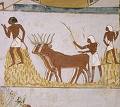
African agriculture was well underway says John
Reader:
Contrary to the claims of some that African agriculture depended on
demic diffusion from outsiders, historian John Reader shows African
agriculture to be well underway on the continent, without any need for
Near Eastern migrants to "jump start" it. Also contrary to popular
conception, early agriculture in the Nile Valley did not first become
important due to cultivation dependent on the overflow of the Nile River.
The genesis of early agriculture lay in exploitation of the Sahara which
was often lush and green in earlier eras. To this was added exploitation
of the fish resources in many watered areas in this region, including but
not limited to the banks of the Nile. Small scale movement of Near Eastern
domesticates were added to this already established mix, over the
centuries, but in short, the ancient inhabitants of the Nile Valley had a
productive economy in operation long ago, and did not need to wait for
reputed European or Caucasoid migrants or colonist to diffuse the
knowledge of agriculture to them. Furthermore the move towards dynastic
consolidation is from the south to the north, again contradicting claims
of colonization and/or formative "advancement" brought from the
Mediterranean or Mesopotamia, or areas like Palestine, or Lebanon.
Excerpt from Africa: A Biography of the Continent,
by
John Reader, Penguin Books, 1998, pp. 120-173
"Deliberate control of plant productivity dates back to 70,000
years ago in southern Africa, and the world's earliest known centrally
organized food production system was established along the Nile 15,000
years ago, long before the Pharaohs, then swept away by calamitous changes
in the river's flow pattern."
"Agriculture is essentially a process
of manipulating the distribution and growth of plants so that greater
quantities of their edible parts are available for harvesting and
consumption. The world's earliest known evidence of natural resources
having been manipulated in this way comes from archaeological excavations
at the Klasies River cave site in South Africa.."
“The human
populations of Africa which have survived the bad times of the last
glacial maximum were well adapted to take advantage of the good times that
followed. Their archaeological visibility increased rapidly, and a steady
proliferation of rock engraving, painting, and decorative items in the
record points to cultural systems of heightening sophistication. As for
food-production systems underpinning this population growth and burgeoning
cultural sophistication, two innovations are particularly relevant, in
that each represents an important stage of technological development and
both are clues to the future of humanity.”
“The first is the
digging-stick weight, which is simply a large stone with a hole bored
through the middle. The stone fits on the stick and its weight lends added
force as the point is thrust into the ground. Digging-stick weights appear
in the African archaeological record during the last glacial maximum, and
their invention suggests that food-gathering technology had been improved
in response to the greater importance of subterranean foods-roots, tubers,
and corms- during the period of climatic stress. The second innovation is
the projectile point, made for use on the spear or the bow and arrow…..
the evidence of projectile-point technology in Africa pre-dates that from
any other part of the world…..and there can be no doubt that the spear and
the bow would have made hunting a more reliable source of protein and fat
during bad times.”
“The digging-stick represents the beginnings of
agriculture and the trend towards a sedentary way of life. The projectile
point represents a refinement of human capacity for taking
life.”
“Agriculture supported life, and the projectile point denied
it. Both factors were evident during the millennia which followed the last
glacial maximum. In climatic terms, the good times continued
uninterruptedly, and the human population increased exponentially. The
attempts to manipulate food production which mark the beginnings of
agriculture encouraged extended use of areas that previously would have
been visited only temporarily. Successful attempts raised population size
above the carrying capacity of the land.“
“In the course of the
2,000 years immediately prior to the last glacial maximum 18,000 years
ago, the number of sites in the Nile valley increased four-fold; during
the following 2,000 years (18,000 to 16,000 years ago) the number almost
doubled again, and it increased by yet another one-third between 16,000
and 14,000 years ago. By 12,000 years ago, the number of occupation sites
along the Nile valley was more than ten times the number known from before
the last glacial maximum, 6,000 years earlier.”
“Throughout this
period the majority of sites had covered an area about 400 m (the home
base for a group of perhaps forty people), but the size of the largest
rose from 800 m 18,000 years ago to more than 10,000 m 6,000 years later –
large enough to constitute a village.”
“During the 1960’s, an
international team of archaeologists discovered a burial ground about
three kilometers north of Wadi Halfa in the Sudan….Excavations uncovered
the skeletons of fifty-nine men, women and children, who had been buried
in shallow graves under thin slabs of sandstones sometime between 14,000
and 12,000 years ago….Points were found wedged in the spine, and embedded
in the skull, the pelvis, and the limb bons”
"The mainstays of the
system were catfish and wetland (and possible wild grass grains), which
were abundantly available at certain times of the year – catfish in
summer, wetland tubers in winter – when surpluses were harvested and
stored for consumption during the months of the year when food was less
readily available.”
“Harvesting and storage mark the beginning of
organized food production: agriculture. But at that stage of its
development in the Nile valley organized food production was a high-risk
strategy. Output was likely to vary unpredictably, and any increase in
population size resulting from a succession of good years would inevitably
lead to competition in less favorable times. The burials at Jebel Sahaba
(Wadi Halfa) probably record one such episode of violent competition, or
warfare, for limited resources of a less than luxuriant Nile valley that
was surrounded by an utterly inhospitable desert.”
“The adoption of
this broad adaptive strategy provided the large food supply needed by a
growing population, but achieving maximum production called for a good
deal of planning and the management of labour. This marks the beginning of
an organized food-producing system: agriculture.”
“Dating from more
than 15,000 years ago, the evidence from the Nile valley is arguably the
earliest comprehensive instance of an organized food-producing system
known anywhere on Earth. Given time, this pioneering system might have
developed into the stupendous civilizations that ruled ancient Egypt for
two and a half millennia from about 5,000 years ago. But it could never
be. Disaster struck the Nile valley as its population reached a peak, and
by 10,000 years ago occupation density had plunged to a level only
slightly above that known for the time of the Wadi Kubbaniya site.”
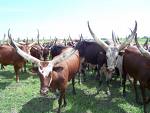
New genetic evidence indicates that Africans
domesticated cattle independently of the Near East
Gene Study Traces Cattle
Herding in Africa, by Ben Harder, National
Geographic News, April 11, 2002, retrieved April 7, 2008 from news.nationalgeographic.com/news/2002/04/0411_020411_africacattle.html
Brief excerpt:
"But new evidence, reported in the April 12 issue of
the journal Science, suggests that Africans independently
domesticated cattle.
Belgian geneticist Olivier Hanotte, who headed the new study, said the
research "reconciles the two schools of thought" about how cattle
domestication occurred in Africa.
"There were Near Eastern influences" on African herds, he said, "but
they came after local domestication."
Since then, there has been considerable mixing of African and Asian
breeds.
Unusual Pattern
In general, the domestication of cattle and other livestock has
followed the establishment of agriculture. But archaeological research has
shown that the domestication of cattle unfolded differently in Africa than
elsewhere in the world.
In many parts of Africa, people herded cattle long before agriculture
was introduced from the Near East and south Asia. Some African groups that
have herded cattle for centuries have never adopted agriculture at all, or
have done so only recently. One example is the Masai of eastern Africa,
who rarely slaughter cattle but instead mix the milk and blood of the
animals to create a staple of their diet.
Intrigued by the uncommon pattern of cattle domestication in Africa,
Hanotte moved to Kenya in 1995 in an effort to explain the development. He
and other researchers in Europe began untangling layers of genetic
information in cattle DNA to help answer major questions about the history
of herding in Africa.
Their findings offer scientists and herders a virtual history book
describing how cattle, crucial to so many Africans, came to be so
genetically diverse. The research also underscores why preserving that
variety is essential.
Hanotte and his colleagues analyzed more than a dozen segments of the
cattle genome. Because the sections they looked at don't affect how "fit"
an animal is evolutionarily, they aren't subject to the effects of natural
selection.
As a result, those genetic segments record the genetic twists and turns
of different cattle lineages and, in the language of DNA, serve as scribes
of bovine history.
The researchers compared this DNA material among many individual cattle
belonging to 50 different herds in 23 African nations. Herders,
scientists, and government officials in those countries aided the study by
tracking down sometimes-remote herds, testing them, and transmitting the
data to Hanotte and his team.
When Hanotte and his colleagues analyzed the samples of cattle DNA,
they found that the variation associated with certain segments of genetic
code reveal a telling geographic pattern across Africa.
The nature of genetic variation changed like the colors of a rainbow as
the researchers looked at cattle from West Africa, Central Africa, and
southern Africa. The greatest amount of genetic diversity was found among
herds in Central Africa.
Based on the data, Hanotte and his colleagues concluded that people
living in Central Africa developed cattle domestication on their own, and
that the techniques—or the herders themselves—gradually migrated toward
the west and the south, spreading domestication across the continent.
Mixed Origins
In looking at the wide genetic variation among African cattle, the
researchers found evidence of interbreeding between cattle native to
Africa and an imported breed.
Most modern African herds represent mixtures of two breeds: Africa's
native cattle, called taurines (Bos taurus), and a slightly larger
Asian breed, known as zebu (Bos indicus), which was domesticated
before it arrived in Africa.
Long-distance trade across the Indian Ocean brought many domesticated
plants and animals to Africa, including the chicken and camel and cereals
such as finger millet and sorghum. Presumably, Hanotte said, trade also
brought zebu bulls that farmers interbred with domesticated taurine cows,
producing the mixed herds of today.
Some variation in the African herds is also attributable to European
influences, Hanotte said. These genetic contributions came in the past few
hundred years, during Europe's colonial influence in Africa.
For thousands of years, animal farmers have gradually improved their
livestock by selectively breeding animals with different desired traits to
endow the offspring with valuable combinations of traits. .."
Full citation: Science 12 April 2002: Vol. 296. no. 5566, pp. 336 -
339, "African Pastoralism: Genetic Imprints of Origins and Migrations,"
Olivier Hanotte, 1* Daniel G. Bradley,2 Joel W. Ochieng,1 Yasmin Verjee,1
Emmeline W. Hill,2 J. Edward O. Rege3 |
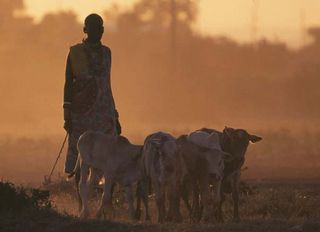
More new research shows that Africans independently
domesticated cattle and carried out their own internal "diffusion" of
cattle culture from east to south, independently of Near East or
Europe
Y-chromosomal evidence of a pastoralist
migration through Tanzania to southern Africa
by Brenna
M. Henn, Christopher Gignoux,, Alice A. Lin, et al.
PNAS August 5, 2008
vol. 105 no. 31 10693–10698
Abstract
Although geneticists have
extensively debated the mode by which agriculture diffused from the Near
East to Europe, they have not directly examined similar agropastoral
diffusions in Africa. It is unclear, for example, whether early instances
of sheep, cows, pottery, and other traits of the pastoralist package were
transmitted to southern Africa by demic or cultural diffusion. Here, we
report a newly discovered Y-chromosome-specific polymorphism that defines
haplogroup E3b1f-M293. This polymorphism reveals the monophyletic
relationship of the majority of haplotypes of a previously paraphyletic
clade, E3b1-M35*, that is widespread in Africa and southern Europe. To
elucidate the history of the E3b1f haplogroup, we analyzed this haplogroup
in 13 populations from southern and eastern Africa. The geographic
distribution of the E3b1f haplogroup, in association with the
microsatellite diversity estimates for populations, is consistent with an
expansion through Tanzania to southern-central Africa. The data suggest
this dispersal was independent of the migration of Bantu-speaking peoples
along a similar route. Instead, the phylogeography and microsatellite
diversity of the E3b1f lineage correlate with the arrival of the
pastoralist economy in southern Africa. Our Y-chromosomal evidence
supports a demic diffusion model of pastoralism from eastern to southern
Africa ˜2,000 years ago.
Limited views of African cattle domestication often
fail to take into account the original genetic diversity of the African
species. This diversity may have been modified over time into a more
standardized type, but the indigenous domestication of the African breeds still
stands.
"Hanotte et al. used allele frequencies from 50 populations of modern cattle across the African continent to examine genetic variation. Their results reveal three ancient genetic signatures and each signature’s center of origin or region of entry. The native African taurine breed was independently domesticated in northeastern Africa, perhaps the eastern Sahara, and later migrated with pastoralist or crop-livestock farmers west and south. Asian zebu cattle were introduced along the east coast of Africa and in Madagascar and were most likely transported along a marine route from the Indian subcontinent. Finally, Near Eastern and European taurine cattle were primarily introduced along the shores of North Africa during the colonial period. These findings provide a genetic record of African cattle origins and migrations that have far-reaching implications for human migrations and the adaptive strategies used by African populations. They also require us to reexamine the models of domestication more broadly."
( M. A. Kennedy. The Origins of African Cattle. Current Anthropology Volume 44, Number 1, February 2003)
"Most (94%) modern cattle populations from
Northern Africa carry haplogroup T1, which is rarely found outside of
Africa (6% in the Near East and absent elsewhere). In contrast, modern
populations from mainland Europe carry 2 very similar haplogroups, T and
T3 (94%), which decrease in the Middle East (65%-74%) and almost
completely disappear in Africa (6%). Haplogroup T2 makes up the remainder
of this mtDNA diversity and is present at 6% in Europe and 21%-27% in the
Near East, but is absent from Africa. These haplogroup distributions have
been interpreted as indicating a Near East origin for European B. taurus
and the independent domestication of cattle in Africa (Bradley et al.
1996, Troy et al. 2001, Hanotte et al. 2002)... ancient DNA sequences
raise the possibility that the mtDNA gene pool for Northern African cattle
was more diverse ca. 900-2000 yr ago..
In conclusion, our results raise the possibility that the mtDNA gene pool for Northern African cattle ca. 900-2000 yr ago was more polymorphic in terms of the frequencies of the T1 and T/T3 haplogroups that currently predominate in African and European populations, respectively. This older polymorphism in Northern African cattle may reflect a transition from an even more diverse ancestral gene pool (as characteristic of its Near East progenitor) and/or the later secondary introduction of T/T3 haplotypes into this region by the immigration of European cattle
(Hanotte et al.2002, Bruford et al. 2003). Concomitantly, selective pressures from domestication and breeding efforts and/or genetic drift may have then led to the final homogenization of this older polymorphism into the current situation of essentially only the T1 haplogroup occurring in Northern Africa. These possibilities reemphasize the fact that both ancient and modern DNA data are of value in the ultimate resolution of the complex history of African cattle (Edwards et al. 2004)."
( Ascunce et al. 2007, An Unusual Pattern of Ancient Mitochondrial DNA Haplogroups in Northern African Cattle.
Zoological Studies 46(1): 123-125.)
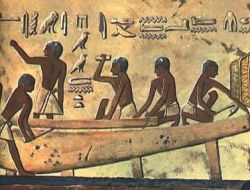
Keita and Boyce on peopling of the Nile Valley and
demic diffusion
From:
Keita and Boyce, Genetics, Egypt, And History: Interpreting
Geographical Patterns Of Y Chromosome
Variation,
History in Africa
32 (2005) 221-246
Ovacaprines appear in the western desert before the Nile valley proper
(Wendorf and Schild 2001). However, it is significant that ancient
Egyptian words for the major Near Eastern domesticates - Sheep, goat,
barley, and wheat - are not loans from either Semitic, Sumerian, or
Indo-European. This argues against a mass settler colonization (at
replacement levels) of the Nile valley from the Near East at this time.
This is in contrast with some words for domesticates in some early Semitic
languages, which are likely Sumerian loan words (Diakonoff 1981).. This
evidence indicates that northern Nile valley peoples apparently
incorporated the Near Eastern domesticates into a Nilotic foraging
subsistence tradition on their own terms (Wetterstrom 1993). There was
apparently no “Neolithic revolution” brought by settler colonization, but
a gradual process of neolithicization (Midant-Reynes 2000). (Also some of
those emigrating may have been carrying Haplotype V, descendents of
earlier migrants from the Nile valley, given the postulated “Mesolithic”
time of the M35 lineage emigration). It is more probable that the current
VII and VIII frequencies, greatest in northern Egypt, reflect in the main
(but not solely) movements during the Islamic period (Nebel et al. 2002),
when some deliberate settlement of Arab tribes was done in Africa, and the
effects of polygamy. There must also have been some impact of Near
Easterners who settled in the delta at various times in ancient Egypt
(Gardiner 1961). More recent movements, in the last two centuries, must
not be forgotten in this assessment.
“Archeological data, or the
absence of it, have been interpreted as suggesting a population hiatus in
the settlement of the Nile Valley between Epipaleolithic and the
Neolithic/predynastic, but this apparent lack could be due to material now
being covered over by the Nile (see Connor and Marks 1986, Midant-Reynes
2000, for a discussion). Analogous to events in the Atacama Desert in
Chile (Nunez et al. 2002), a moister more inhabitable eastern Sahara
gained more human population in the late Pleistocene-early Holocene
(Wendorf and Schild 1980, Hassan 1988, Wndorf and Schild 2001). If the
hiatus was real then perhaps many Nile populations became Saharan.
Later, stimulated by mid-Holocene droughts, migration from the
Sahara contributed population to the Nile Valley (Hassan 1988, Kobusiewicz
1992, Wendorf and Schild 1980, 2001); the predynastic of upper Egypt and
later Neolithic in lower Egypt show clear Saharan affinities. A striking
increase of pastoralists’ hearths are found in the Nile valley dating to
between 5000-4000 BCE (Hassan 1988). Saharan Nilo-Saharan speakers may
have been initial domesticators of African cattle found in the Sahara (see
Ehret 2000, Wendorf et. Al. 1987). Hence there was a Saharan “Neolithic”
with evidence for domesticated cattle before they appear in the Nile
valley (Wendorf et al. 2001). If modern data can be used, there is no
reason to think that the peoples drawn into the Sahara in the earlier
periods were likely to have been biologically or linguistically uniform.
…A dynamic diachronic interaction consisting of the fusion,
fissioning, and perhaps “extinction” of populations, with a decrease in
overall numbers as the environment eroded, can easily be envisioned in the
heterogenous landscape of the eastern Saharan expanse, with its oases and
Wadis, that formed a reticulated pattern of habitats. This fragile and
changing region with the Nile Valley in the early to mid-Holocene can be
further envisioned as holding a population whose subdivisions maintained
some distinctiveness, but did exchange genes. Groups would have been
distributed in settlements based on resources, but likely had contacts
based on artifact variation (Wendorf and Schild 2001). Similar pottery can
be found over extensive areas. Transhumance between the Nile valley and
the Sahara would have provided east-west contact, even before the later
migration largely emptied parts of the eastern Sahara.
Early speakers
of Nilo-Saharan and Afroasiatic apparently interacted based on the
evidence of loan words (Ehret, personal communication). Nilo-Saharan’s
current range is roughly congruent with the so-called Saharo-Sudanese or
Aqualithic culture associated with the less arid period (Wendorf and
Schild 1980), and therefore cannot be seen as intrusive. Its speakers are
found from the Nile to the Niger rivers in the Sahara and Sahel, and south
into Kenya. The eastern Sahara was likely a micro--evolutionary processor
and pump of populations, who may have developed various specific
sociocultural (and linguistic) identities, but were genealogically “mixed”
in terms of origins.
These identities may have further
crystallized on the Nile, or fused with those of resident populations that
were already differentiated. The genetic profile of the Nile Valley via
the fusion of the Saharans and the indigenous peoples were likely
established in the main long before the Middle
Kingdom…
…Hoffman (1982) noted cattle burials in Hierakonpolis,
the most important of predynastic upper Egyptian cities in the later
predynastic. This custom might reflect Nubian cultural impact, a common
cultural background, or the presence of Nubians.
There was some
cultural and economic bases for all levels of social intercourse, as well
as geographical proximity. There was some shared iconography in the
kingdoms that emerged in Nubia and upper Egypt around 3300 BCE (Williams
1986). Although disputed, there is evidence that Nubia may have even
militarily engaged upper Egypt before Dynasty I, and contributed
leadership in the unification of Egypt (Williams 1986). The point of
reviewing these data is to illustrate that evidence suggests a basis for
social interaction, and gene exchange.
There is a caveat for Lower
Egypt. If Neolithic/predynastic northern Egyptian populations were
characterized at one time by higher frequencies of VII and VIII (from Near
Eastern migration), then immigration from Saharan souces could have
brought more V and XI in the later northern Neolithic. It should further
be noted that the ancient Egyptians interpreted their unifying king,
Narmer (either the last of Dynasty 0, or the first Dynasty I), as having
been upper Egyptian and moving from south to north with victorious armies
(Gardiner 1961, Wilkinson 1999). However, this may only be the heraldic
“fixation” of an achieved political and cultural status quo (Hassan 1988),
with little or no actual troup/population movements. Nevertheless, it is
upper Egyptian (predynastic) culture that comes to dominate the country
and emerges as the basis of dynastic cilization. Northern graves over the
latter part of the predynastic do become like those in the south (see Bard
1994); some emigration to the north may have occurred - of people as well
as ideas.
Interestingly, there is evidence from skeletal biology
that upper Egypt in large towns at least, was possibly becoming more
diverse over time due to immigration from northerners, as the
sociocultural unity proceeded during the predynastic, at least in some
major centers (Keita 1992, 1996). This could indicate that the south had
been impacted by northerners with Haplotypes V, VII, and VIII, thus
altering southern populations with higher than now observed levels of IV
and XI, if the craniometric data indicate a general phenomenon, which is
not likely. The recoverable graves associated with major towns are not
likely reflective of the entire population. It is important to remember
that population growth in Egypt was ongoing, and any hypothesis must be
tempered with this consideration.
Dynasty I brought the political
conquest (and cultural extirpation?) of the A-Group Nubian kingdom Ta Seti
by (ca. 3000 BC) Egyptian Kings (Wilkinson 1999). Lower Nubia seems to
have become largely “depopulated,” based on archeological evidence, but
this more likely means that Nubians were partially bioculturally
assimilated into southern Egypt. Lower Nubia had a much smaller population
than Egypt, which is important to consider in writing of the historical
biology of the population. It is important to note that Ta Seti (of Ta
Sti, Ta Sety) was the name of the southernmost nome (district) of upper
Egypt recorded in later times (Gardiner 1961), which perhaps indicates
that the older Nubia was not forgotten/obliterated to historical memory.
Depending on how “Nubia” is conceptualized, the early kingdom
seems to have more or less become absorbed politically into Egypt. Egypt
continued activities in Nubia in later Dynasty I (Wilkinson 1999, Emery
1961).”
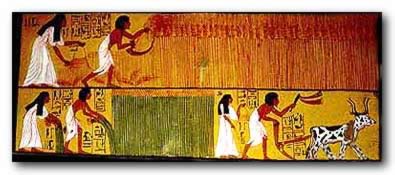
Linguist C. Ehret on why various theories of
demic diffusion from the Near East are flawed as to Africa
"Furthermore, the archaeology of northern Africa DOES NOT SUPPORT
demic diffusion of farming from the Near East. The evidence presented by
Wetterstrom indicates that early African farmers in the Fayum initially
INCORPORATED Near Eastern domesticates INTO an INDIGENOUS foraging
strategy, and only OVER TIME developed a dependence on horticulture.
This is inconsistent with in-migrating farming settlers, who would have
brought a more ABRUPT change in subsistence strategy. "The same
archaeological pattern occurs west of Egypt, where domestic animals and,
later, grains were GRADUALLY adopted after 8000 yr B.P. into the
established pre-agricultural Capsian culture, present across the
northern Sahara since 10,000 yr B.P. From this continuity, it has been
argued that the pre-food-production Capsian peoples spoke languages
ancestral to the Berber and/or Chadic branches of Afroasiatic, placing
the proto-Afroasiatic period distinctly before 10,000 yr B.P."
Source: The Origins of Afroasiatic
Christopher Ehret, S. O.
Y. Keita, Paul Newman;, and Peter Bellwood
Science 3 December 2004:
Vol. 306. no. 5702, p. 1680
Movement and migration of peoples are sometimes related to
climate. Changing Saharan climate for example had an effect on the
movement of peoples in and out of Egypt. Tropically adapted peoples have
always been included in that movement, and show a continuity in the
population throughout Egyptian history.
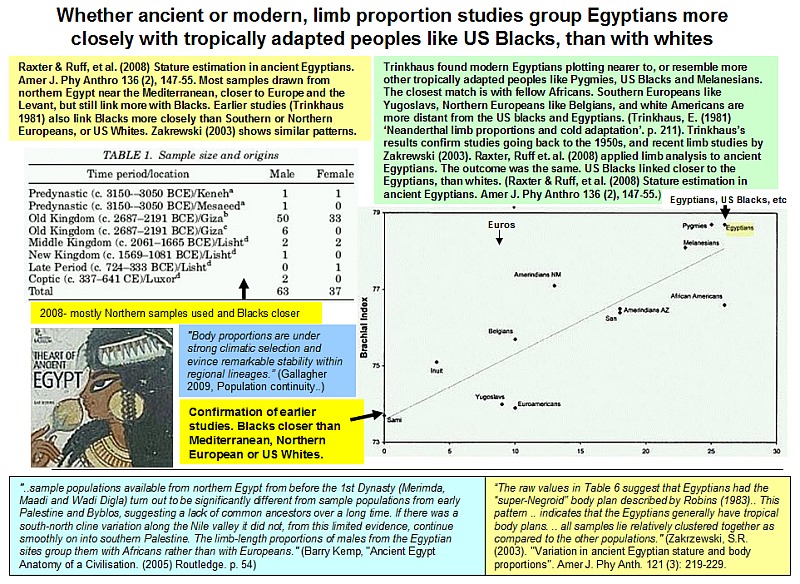
|


![]()
![]()


